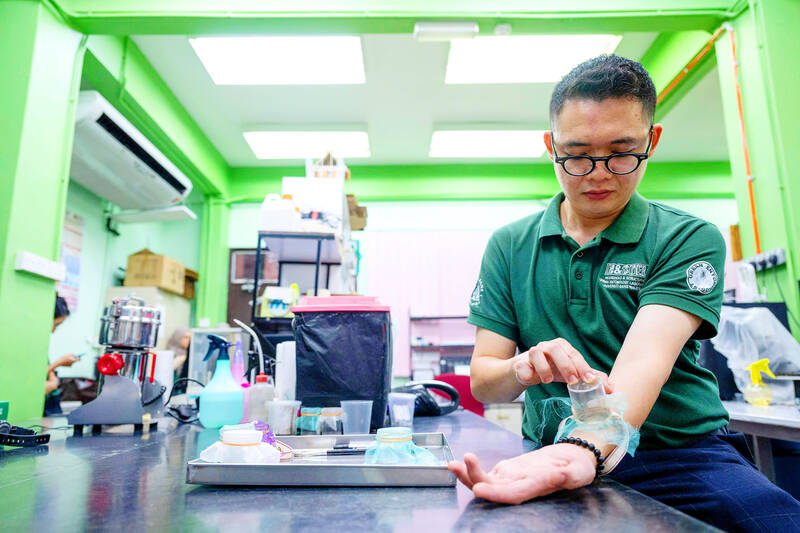Under glaring laboratory lights, a research assistant extends his forearm and carefully inverts a mesh-topped container onto his skin to allow a wriggling mass of bed bugs to feed on his blood, all in the name of science.
Loathed as itchy household pests, the blood-sucking insects have revealed a darker, more intriguing potential as Malaysian scientists have discovered they can be turned into unlikely crime-busting allies.
A team from the Science University of Malaysia (USM) in northern Penang has found that tropical bed bugs can retain DNA from human prey for up to 45 days after snacking on an unwary victim.

Photo: AFP
This makes the tiny critters, who love to lurk in headboard cracks, mattress seams and pillow covers, ideal evidence resources when it comes to pinpointing suspects at crime scenes.
From a speck of blood, police investigators might one day be able to piece together the full profile of an offender, if the critters are present at a crime scene.
Analyzing the insects could reveal gender, eye color, hair and skin color, entomologist Abdul Hafiz Ab Majid said.
“We call bed bugs the musuh dalam selimut [the enemy in the blanket],” Hafiz said, adding that “they can also be spies” to help solve crimes.
In a laboratory tucked deep inside USM’s School of Biological Sciences, Hafiz and postdoctoral researcher Lim Li have spent nearly half a decade studying tropical bed bugs.
The bloodsuckers, scientific name Cimex hemipterus, are the most common species found in Malaysia and the tropics.
The bugs are reared in containers under a laboratory bench, each wrapped in black plastic to mimic conditions the insects thrive in.
“We place folded pieces of paper inside the small containers so the bed bugs have something to climb on,” Hafiz said.
With the laboratory’s temperature kept at a constant 23°C to 24°C, the insects suck up 1.5 to 5.3 microliters of blood at each feeding, an “amount less than a droplet,” Hafiz said.
Researchers found DNA extracted from bed bugs that had fed on human blood could recover basic “phenotypic profiling,” a person’s observable traits, as well as gender for up to 45 days.
Using so-called Short Tandem Repeat (STR) and Single Nucleotide Polymorphism (SNP) markers, specific DNA sequences extracted from the blood, researchers can determine the gender, eye, hair and skin color of potential suspects, long after they have fled the scene.
The USM study called “Human profiling from STR and SNP analysis of tropical bed bug, Cimex hemipterus”, was published in Nature Scientific Reports two years ago.
It was the first documented forensic use involving tropical bed bugs.
Unlike mosquitoes and flies, bed bugs cannot fly, and once they have fed, “become engorged and can’t move around that much,” Hafiz said, adding that they can only move within 6m of where they have fed.
“That’s what makes them unique. We can say they are perfect to use as a forensic tool compared to mosquitoes that ... fly away,” Hafiz added.
The bugs are particularly useful at crime scenes, where fluids have been wiped away to destroy evidence, as the critters are often well-hidden.
Back in the laboratory, researcher Lim did not hesitate to demonstrate a feeding session, even joking that she had been a “willing victim” for science.
“I let them feed on my blood when I wanted to test how long [it would take] the human DNA to degrade,” she said.
Lim said that the inconspicuous bugs are “misunderstood creatures” and do not spread diseases — even though their bite leaves an itchy rash that can last for weeks.
“Maybe we can try educating people because the bed bugs are not actually vectors. So even if you get bitten, they can’t transmit diseases to you,” she said.
While the researchers imagined a future where tiny bed bugs at crime scenes could lead investigators to murder suspects, Hafiz said the insects are not a magic fix.
Bed bugs have their limits — especially when it comes to cracking cold cases, he said.
“It only gives investigators a time frame of 45 days to use bed bugs as evidence — and only if they are available at the crime scene,” Hafiz said.

DISASTER: The Bangladesh Meteorological Department recorded a magnitude 5.7 and tremors reached as far as Kolkata, India, more than 300km away from the epicenter A powerful earthquake struck Bangladesh yesterday outside the crowded capital, Dhaka, killing at least five people and injuring about a hundred, the government said. The magnitude 5.5 quake struck at 10:38am near Narsingdi, Bangladesh, about 33km from Dhaka, the US Geological Survey (USGS) said. The earthquake sparked fear and chaos with many in the Muslim-majority nation of 170 million people at home on their day off. AFP reporters in Dhaka said they saw people weeping in the streets while others appeared shocked. Bangladesh Interim Leader Muhammad Yunus expressed his “deep shock and sorrow over the news of casualties in various districts.” At least five people,

ON THE LAM: The Brazilian Supreme Court said that the former president tried to burn his ankle monitor off as part of an attempt to orchestrate his escape from Brazil Former Brazilian president Jair Bolsonaro — under house arrest while he appeals a conviction for a foiled coup attempt — was taken into custody on Saturday after the Brazilian Supreme Court deemed him a high flight risk. The court said the far-right firebrand — who was sentenced to 27 years in prison over a scheme to stop Brazilian President Luiz Inacio Lula da Silva from taking office after the 2022 elections — had attempted to disable his ankle monitor to flee. Supreme Court judge Alexandre de Moraes said Bolsonaro’s detention was a preventive measure as final appeals play out. In a video made

It is one of the world’s most famous unsolved codes whose answer could sell for a fortune — but two US friends say they have already found the secret hidden by Kryptos. The S-shaped copper sculpture has baffled cryptography enthusiasts since its 1990 installation on the grounds of the CIA headquarters in Virginia, with three of its four messages deciphered so far. Yet K4, the final passage, has kept codebreakers scratching their heads. Sculptor Jim Sanborn, 80, has been so overwhelmed by guesses that he started charging US$50 for each response. Sanborn in August announced he would auction the 97-character solution to K4

SHOW OF FORCE: The US has held nine multilateral drills near Guam in the past four months, which Australia said was important to deter coercion in the region Five Chinese research vessels, including ships used for space and missile tracking and underwater mapping, were active in the northwest Pacific last month, as the US stepped up military exercises, data compiled by a Guam-based group shows. Rapid militarization in the northern Pacific gets insufficient attention, the Pacific Center for Island Security said, adding that it makes island populations a potential target in any great-power conflict. “If you look at the number of US and bilateral and multilateral exercises, there is a lot of activity,” Leland Bettis, the director of the group that seeks to flag regional security risks, said in an